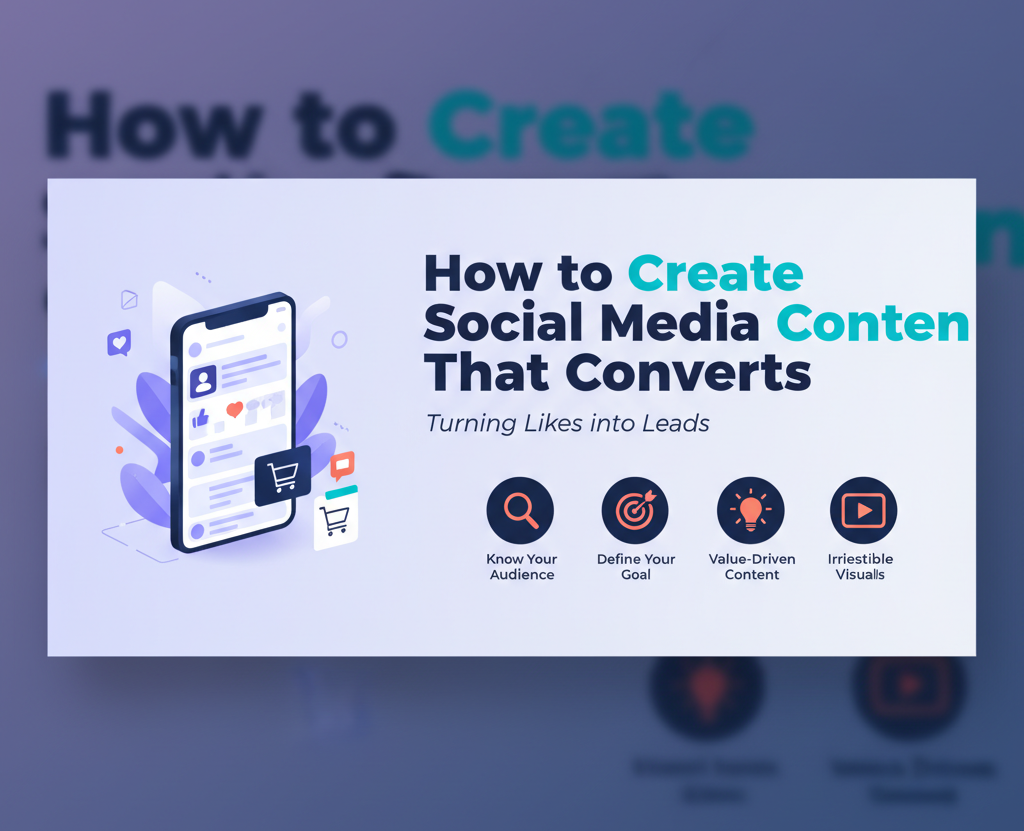How to Create Social Media Content That Converts: Turning Likes into Leads
In today’s crowded digital landscape, it’s not enough to just post on social media. You need to create content that doesn’t just get likes, but actually drives action – content that converts. Whether you’re looking to generate leads, boost sales, or grow your email list, your social media presence needs to be more than just a gallery; it needs to be a conversion engine.
But how do you move beyond vanity metrics and craft content that genuinely impacts your bottom line? As seasoned social media marketing experts, we’re here to break down the strategies that transform passive scrolling into active engagement and ultimately, conversions.
1. Know Your Audience (Inside and Out)
This is the bedrock of all successful marketing, and social media is no exception. Before you even think about what to post, you need to deeply understand who you’re talking to.
- Who are they? Demographics (age, location, income), psychographics (interests, values, lifestyle), pain points, aspirations.
- What platforms do they frequent? Are they on TikTok for quick, engaging videos, or LinkedIn for professional insights?
- What problems do they need solved? Your content should offer solutions or inspiration relevant to their lives.
The better you know your audience, the more targeted and resonant your content will be. This resonance is what sparks interest and nudges them towards your conversion goal.
2. Define Your Conversion Goal for Each Piece of Content
Every piece of content you put out should have a purpose. What do you want people to do after seeing it?
- Sign up for your newsletter?
- Download a free guide?
- Visit a product page?
- Book a consultation?
- Make a purchase?
When you have a clear goal, you can tailor your message, visual, and call-to-action (CTA) to guide users precisely where you want them to go.
3. Embrace the Power of Value-Driven Content
People scroll through social media looking for entertainment, information, or solutions – not always for a direct sales pitch. Your content should offer value first.
- Educate: Share tips, tricks, how-tos, industry insights.
- Inspire: Tell stories, share success testimonials, provide motivational content.
- Entertain: Use humor, relatable memes (if appropriate for your brand), engaging visuals.
- Solve Problems: Address common questions, offer quick fixes, or introduce your product/service as the ultimate solution.
When you consistently provide value, you build trust and authority, making your audience more receptive when you do present a conversion opportunity.
4. Craft Irresistible Visuals That Stop the Scroll
Social media is a visual medium. Your images and videos are your first impression.
- High-Quality is Non-Negotiable: Blurry, poorly lit visuals are instant turn-offs. Invest in good photography or design tools.
- Brand Consistency: Use your brand colors, fonts, and style to ensure instant recognition.
- Emotional Connection: Does your visual evoke curiosity, joy, aspiration, or relief?
- Video Dominance: Short, engaging videos (reels, stories, TikToks) are incredibly powerful for capturing attention and conveying a message quickly. Show, don’t just tell.
5. Write Compelling Copy That Demands Attention
Your visuals grab the eye, but your copy holds the interest and drives the action.
- Hook Them Immediately: Start with a question, a bold statement, or a surprising statistic to pull them in.
- Focus on Benefits, Not Just Features: Instead of saying “Our software has X feature,” explain “Our software helps you save Y hours a week.”
- Keep it Concise (But Informative): Different platforms have different copy length tolerances. Get to the point quickly, but provide enough context to make your CTA meaningful.
- Use Emojis Strategically: Emojis can break up text, add personality, and highlight key points.
- Include a Strong Call-to-Action (CTA): This is where the magic happens!
6. Master the Art of the Call-to-Action (CTA)
A great CTA is clear, concise, and tells users exactly what to do next.
- Be Specific: Instead of “Learn More,” try “Download Your Free Guide,” “Shop Our New Collection,” or “Book Your Discovery Call.”
- Create Urgency/Scarcity (When Appropriate): “Limited Stock,” “Offer Ends Soon,” “Only X Spots Left.”
- Use Action Verbs: “Click,” “Get,” “Sign Up,” “Claim,” “Discover.”
- Make it Easy: Ensure the link is prominent and goes directly to the intended landing page. No extra clicks or confusing navigation!
7. Leverage Social Proof and User-Generated Content (UGC)
People trust recommendations from others more than direct advertising.
- Testimonials and Reviews: Share screenshots of positive feedback or short video testimonials.
- Case Studies: Highlight how your product/service has helped real clients achieve their goals.
- User-Generated Content (UGC): Encourage customers to share their experiences with your brand and repost their content (with permission!). This builds community and acts as authentic social proof.
8. Optimize Landing Pages for Conversion
Your social media content is just the first step. The conversion truly happens on your landing page.
- Seamless Transition: Ensure the message and branding on your landing page are consistent with the social media post.
- Clear Value Proposition: Immediately tell visitors what they will gain.
- Simple Form Fields: Only ask for essential information.
- Strong, Visible CTA: Reiterate the call to action from your social post.
- Mobile Responsiveness: Most social media users are on mobile, so your landing page must look and function perfectly on all devices.
9. Analyze, Learn, and Adapt
Social media marketing is an ongoing process of testing and refinement.
- Track Your Metrics: Pay attention to not just likes and shares, but also click-through rates (CTR) to your landing pages, conversion rates, and the ROI of your social efforts.
- A/B Test: Experiment with different visuals, headlines, copy, CTAs, and even posting times to see what resonates best with your audience.
- Utilize Platform Analytics: Most platforms offer robust analytics to help you understand what’s working and what’s not.
By continuously monitoring your performance and adjusting your strategy, you can optimize your content for maximum conversions.
Creating social media content that converts is a blend of understanding your audience, delivering value, crafting compelling messages, and relentlessly optimizing your approach. It’s about building relationships that naturally lead to business growth. Ready to transform your social media presence from a static feed into a dynamic conversion engine? Contact us today to discuss how our expert social media and email marketing services can help you turn likes into lasting leads.


